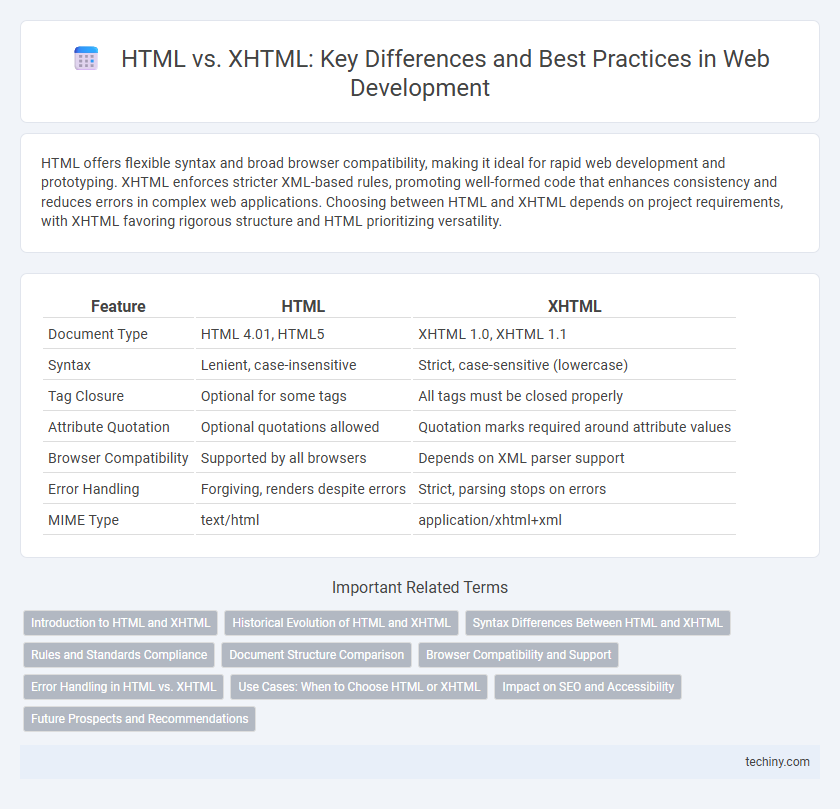HTML offers flexible syntax and broad browser compatibility, making it ideal for rapid web development and prototyping. XHTML enforces stricter XML-based rules, promoting well-formed code that enhances consistency and reduces errors in complex web applications. Choosing between HTML and XHTML depends on project requirements, with XHTML favoring rigorous structure and HTML prioritizing versatility.
Table of Comparison
| Feature | HTML | XHTML |
|---|---|---|
| Document Type | HTML 4.01, HTML5 | XHTML 1.0, XHTML 1.1 |
| Syntax | Lenient, case-insensitive | Strict, case-sensitive (lowercase) |
| Tag Closure | Optional for some tags | All tags must be closed properly |
| Attribute Quotation | Optional quotations allowed | Quotation marks required around attribute values |
| Browser Compatibility | Supported by all browsers | Depends on XML parser support |
| Error Handling | Forgiving, renders despite errors | Strict, parsing stops on errors |
| MIME Type | text/html | application/xhtml+xml |
Introduction to HTML and XHTML
HTML (HyperText Markup Language) serves as the standard language for creating web pages, enabling the structuring of content with tags and elements. XHTML (Extensible HyperText Markup Language) is a stricter, XML-based variant of HTML designed to enforce well-formed syntax and enhance compatibility across devices and browsers. Both languages form the foundation of web development, but XHTML requires more rigorous coding practices to ensure compliance with XML standards.
Historical Evolution of HTML and XHTML
HTML initially emerged in the early 1990s as the foundational markup language for structuring web content, evolving through various versions to improve capabilities and browser compatibility. XHTML was introduced in the early 2000s as a stricter, XML-based reformulation of HTML 4.01, designed to enforce rigorous syntax rules and enhance interoperability across browsers and devices. The transition from HTML to XHTML marked a shift towards more precise coding standards, though HTML5 later integrated both languages' strengths by offering flexibility with stricter parsing and richer multimedia support.
Syntax Differences Between HTML and XHTML
HTML syntax allows for flexible coding practices with optional closing tags and case-insensitive elements, whereas XHTML requires strict adherence to XML rules, including mandatory closing tags, lowercase elements, and proper nesting. XHTML documents must be well-formed with all attributes quoted and empty elements self-closed, ensuring compatibility with XML parsers. These syntax differences impact browser behavior and error handling, with XHTML enforcing greater precision for web developers.
Rules and Standards Compliance
HTML follows a more flexible syntax allowing optional closing tags and case-insensitive elements, while XHTML enforces strict XML-based rules requiring well-formed code with proper nesting, lowercase tags, and mandatory closing of all elements. XHTML's rigorous standards compliance ensures better compatibility with XML tools and improved error handling during parsing. Adhering to these strict rules in XHTML promotes cleaner, more consistent markup compared to the looser conventions of traditional HTML.
Document Structure Comparison
HTML uses a flexible, forgiving document structure that allows optional closing tags and case-insensitive element names, facilitating quicker coding but risking inconsistent rendering. XHTML enforces a strict XML-based syntax with mandatory closing tags, case-sensitive element names, and a well-formed document hierarchy, ensuring better compatibility with XML tools and stricter error handling. This structural rigidity in XHTML promotes consistent parsing across different browsers and platforms compared to the more lenient HTML structure.
Browser Compatibility and Support
HTML offers broad browser compatibility with flexible syntax that accommodates legacy and modern browsers, making it ideal for diverse web environments. XHTML enforces stricter XML-based syntax, which enhances code consistency but may cause rendering issues or require fallbacks in browsers that do not fully support XML parsing. Most modern browsers support both, but HTML's permissive nature ensures smoother cross-browser performance and faster development cycles.
Error Handling in HTML vs. XHTML
HTML employs a lenient error-handling approach by allowing browsers to interpret and render malformed code, which often prevents page crashes but can lead to inconsistent displays across different browsers. In contrast, XHTML requires strict compliance with XML syntax rules, causing browsers to halt rendering and display error messages if any syntax errors are found, ensuring more consistent and predictable behavior. This rigorous error handling in XHTML facilitates better validation and improved code quality, crucial for complex web applications requiring robust structure.
Use Cases: When to Choose HTML or XHTML
HTML is ideal for rapid prototyping and projects where flexibility and browser compatibility are priorities, as it supports loose syntax and is widely supported by modern browsers. XHTML is preferred for applications requiring strict XML compliance, such as data-driven sites or when integrating with XML tools and parsers to ensure well-formed code and easier data manipulation. Choosing between HTML and XHTML depends on project needs for extensibility, parsing requirements, and the development environment's strictness in enforcing markup rules.
Impact on SEO and Accessibility
HTML provides flexibility in coding but may allow errors that affect SEO and accessibility, whereas XHTML enforces stricter syntax rules that enhance code consistency and reduce parsing errors, improving search engine indexing and screen reader compatibility. XHTML's requirement for well-formed documents ensures that browsers and assistive technologies interpret content more reliably, which can boost SEO rankings and provide a better user experience for individuals with disabilities. Web developers prioritizing SEO and accessibility benefits often prefer XHTML's robust structure despite its stricter coding demands.
Future Prospects and Recommendations
XHTML enforces stricter syntax rules than HTML, promoting cleaner code and better compatibility with XML-based technologies, which supports future-proof web development. As browsers and standards continue evolving, adopting XHTML or HTML5 with XML serialization ensures improved maintainability and interoperability across devices. For modern projects, leveraging HTML5 with XHTML constraints balances flexibility and robustness, aligning with future web standards and developer practices.
HTML vs XHTML Infographic

 techiny.com
techiny.com